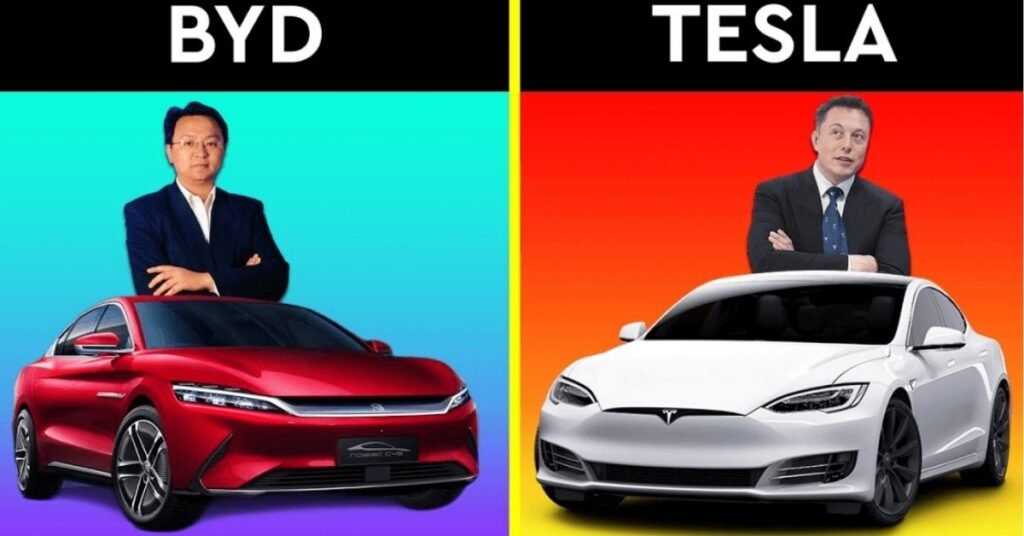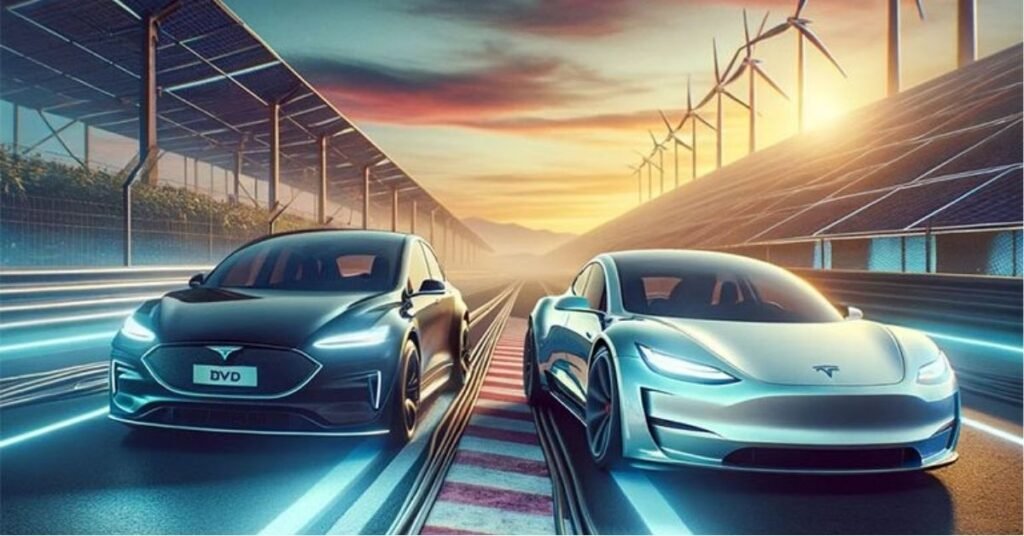In 2025, the electric vehicle (EV) market is witnessing a seismic shift as BYD, the Chinese automaker, unleashes its BYD low-cost EV threat against Tesla’s long-held dominance.
With ultra-affordable models, aggressive global expansion, and a knack for high-volume production, BYD is no longer just a regional player—it’s a global contender shaking up the EV landscape.
As Tesla faces mounting pressure, this article delves into BYD’s strategy, how it stacks up against Tesla, and what this means for U.S. consumers and investors watching the EV race unfold.
BYD’s Pricing Power and Global Ambitions
BYD’s BYD low-cost EV threat hinges on its ability to deliver high-quality EVs at jaw-dropping prices. Models like the BYD Seagull, starting at around $11,000 in China with a 190–252-mile range, and the BYD Dolphin, priced between $20,000–$35,000, are undercutting Tesla’s cheapest Model 3 RWD ($38,000) by a wide margin.
This pricing advantage stems from BYD’s vertically integrated supply chain, producing everything from batteries to semiconductors in-house, slashing costs without sacrificing quality. In 2024, BYD sold 4.3 million vehicles globally, including 1.76 million EVs, outpacing Tesla’s 1.8 million EV sales, largely due to its dominance in China’s massive market.
BYD’s global expansion is equally aggressive. In 2025, the company is penetrating Europe, Latin America, and Southeast Asia, with manufacturing plants in Thailand, Brazil, and plans for India.

In Europe, BYD outsold Tesla in battery electric vehicle (BEV) sales in April 2025, registering 7,231 units versus Tesla’s 7,165.
While BYD’s U.S. entry remains limited due to a 125% tariff on Chinese imports, the company is exploring partnerships and local production to gain a foothold. This scale and affordability make the BYD low-cost EV threat a serious challenge for competitors.
Tesla’s Market Position: Premium vs. Affordable
Tesla remains the EV gold standard in the U.S., commanding a 55% market share in 2023, though down from 65% in 2022.
Its strength lies in premium branding, cutting-edge technology like Full Self-Driving (FSD) software, and a sprawling Supercharger network with over 60,000 chargers worldwide.
Tesla’s Model Y, the world’s best-selling car in 2023 and 2024, starts at $44,990, targeting tech-savvy, upscale buyers.
However, its higher price points and focus on luxury leave it vulnerable to the BYD low-cost EV threat, especially in price-sensitive markets.
Tesla’s gigafactories in the U.S., China, and Germany ensure robust production, but BYD’s cost advantages and broader portfolio, including plug-in hybrids, give it an edge in volume.
Consumer and Analyst Reactions
U.S. consumer sentiment, as seen on platforms like Reddit and Tesla Motors Club, leans heavily toward Tesla for its tech prestige and brand loyalty.
A Reddit user noted, “Tesla’s software and Superchargers make it worth the premium.” However, BYD’s affordability resonates in emerging markets, with a Latin American buyer on X praising the Seagull:
“It’s cheap, reliable, and perfect for city driving.” Industry analysts are split. Some, like those at Acumen Research, see BYD’s BYD low-cost EV threat reshaping markets like Europe, where cost-conscious buyers favor its $20,000–$35,000 models.
Others argue Tesla’s innovation and U.S. dominance will hold firm, citing its advanced 4680 battery cells and AI-driven FSD. Yet, analysts warn that Tesla’s high valuation and Elon Musk’s polarizing public profile could amplify risks if BYD gains U.S. traction.

Risks and Opportunities for Tesla
The BYD low-cost EV threat poses risks for Tesla, particularly in Europe, where its sales dipped 49% in April 2025, while BYD surged 359%.
Tariffs and trade tensions, like the U.S.’s 125% levy, limit BYD’s stateside impact but could push Tesla to lower prices, squeezing margins. Tesla’s reliance on premium segments also risks alienating budget-conscious buyers.
However, opportunities abound: Tesla’s rumored Model 2, a sub-$30,000 EV expected late 2025, could counter BYD’s affordability.
Expanding its Supercharger network and refining FSD could further solidify Tesla’s tech edge. Diversifying into markets like India, where BYD already leads, is another growth avenue.
The Future of the EV Landscape
The BYD low-cost EV threat is reshaping the EV market in 2025, forcing Tesla to rethink its strategy. BYD’s affordability, massive production, and global reach make it a formidable rival, particularly in cost-driven regions.
While Tesla’s innovation and U.S. dominance keep it ahead, the narrowing sales gap BYD’s 1.6 million units vs. Tesla’s 1.3 million in H1 2025 signals a tightening race.
For U.S. consumers, BYD’s limited presence means Tesla remains the go-to, but its influence could grow if tariffs ease or local production ramps up.
For Tesla, countering the BYD low-cost EV threat will require balancing premium appeal with accessible pricing, ensuring it doesn’t cede ground to this Chinese powerhouse.
As the EV revolution accelerates, this rivalry promises to drive innovation and affordability, benefiting drivers worldwide.
Curious about the BYD low-cost EV threat? Stay tuned for updates on how BYD and Tesla are shaping the future of electric vehicles in 2025.
1️⃣1️⃣ Industry Wildcards
— Stockizen Research ll SEBI RA (@Stocki_zen) June 16, 2025
→ China: 60% global EV share – BYD is a low-cost threat to JLR
→ AI/ADAS: Level 3 autonomy in luxury by 2028
→ Sustainability: JLR testing 85% recycled aluminum
→ Chip shortages & tariff traps could derail EV momentum
Also Read: Tesla Model Y Interior Fixes 2025: Amazon Solutions Unveiled

Abdul Basit is a US-based tech writer who covers Apple innovations, Tesla’s EV growth, AI breakthroughs, smartphone trends, and app reviews for global readers.
